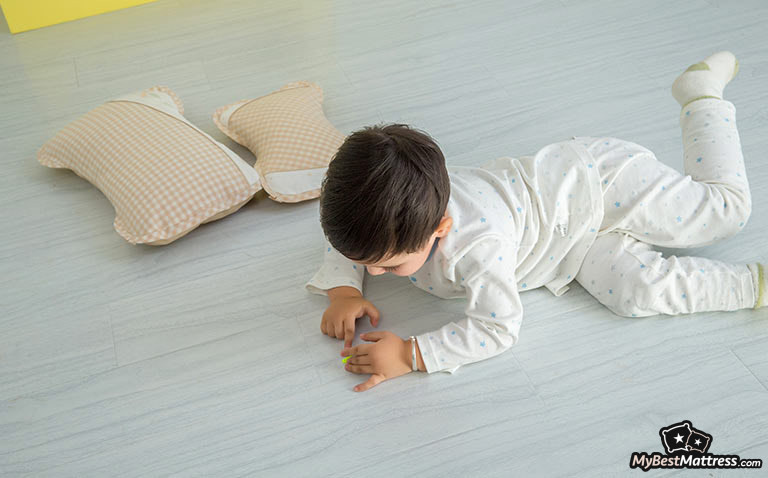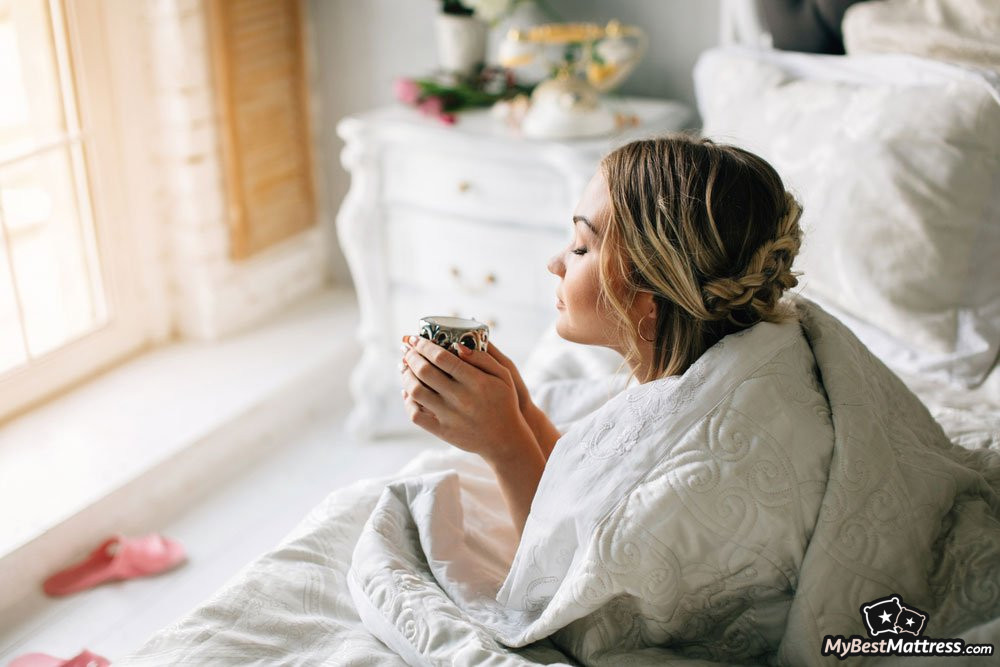
Sleep disorders in children are quite common, however, the connection between autism and sleep is a much more crucial problem that people should be aware of.
According to the AutismSpeaks.org, up to 80% of children with autism experience sleep problems, which can lead to dizziness, daytime sleepiness, studying problems and behavioral issues such as aggression, hyperactivity, and inattentiveness.
And only 10-16% of healthy children have problems sleeping[1]. So, while people with ASD experience a lot of problems as it is, many more difficulties await for those who do not get enough sleep.
Thus, such topics as sleep disorders in children; autism and sleeping should be highly discussed. And that’s what I’m going to do.
In this article, I will provide you with all the needed information about sleep disorders in children with autism. I will introduce you with the most common sleep disorders, issues related to sleep and answer the question, why children with autism are more prone to sleep problems.
You will also get some tips to fight sleep disorders in children and other important information. So, read further into the article to find out everything
Table of Contents
- 1. Sleeping Disorders in Children: Autism and Sleep
- 2. How are Autism and Sleeping Deprivation Related?
- 3. Sleep Disorders in Children with Autism: Tips that Can Help
- 3.1. Create a Bedtime Routine
- 3.2. Make the Bedroom Environment Comfortable
- 3.3. Healthy Choices
- 3.4. Melatonin Supplements
- 3.5. Find a Comfortable Mattress
- 4. Other Sleep Disorders in Children
- 5. Do Not Forget About Yourself
- 6. Conclusions
Sleeping Disorders in Children: Autism and Sleep

Let’s begin with the definition of autism. Autism or autism spectrum disorder (ASD) is a condition, which influences social skills, speech, nonverbal communication, and repetitive behaviors. ASD appears in not one subtype, there are many, however, this disorder is influenced by a number of genetic and environmental factors.
Here are a few indicators that your child has autism:
- Difficulty to understand what other people are feeling
- The lack of social skills
- Avoiding eye contact
- The need for routine
- Difficulty to concentrate
- Repetition of various words, sounds or behaviors
- Slow language development
So, while autism comes in a wide spectrum of behavioral aspects, people with ASD also experience such problems as insomnia or inability to have quality sleep.
Now, since this article is focused on sleep disorders in toddlers and children with ASD, let’s go straight to it.
According to the research[2] you can find in the US National Library of Medicine National Institutes of Health, 53% of children with ASD aged between 2 to 5 years suffered from sleep issues; 86% of children in total had various cases of insomnia.
These problems included bedtime resistance, insomnia, parasomnias, sleep-disordered breathing, problems related to waking up early in the morning and daytime sleepiness. Therefore, there is a lot of evidence related to sleep disorders in children with autism.

How are Autism and Sleeping Deprivation Related?
Children who have ASD are very sensitive to various irritants such as smells, lights, even their clothes, and bedding material. Here are the most common issues of sleep disorders in children with ASD:
- Difficult to fall asleep
- Difficult to wake up early
- Waking up during the night
- Anxiety around bedtime
- Daytime Sleepiness
- Short naps are a problem
As you can see, there are various sleeping issues associated with children that have ASD, but what are the biological reasons? Here are some of the biological causes that influence the sleep of kids with ASD[3]:
- Medical issues. Children with ASD often experience epilepsy, which can make a major influence on sleep.
- Mental issues. It’s known that children with ASD often experience depression and anxiety, which are the main causes of insomnia and other sleep problems. ASD is also associated with ADHD, which is a disorder that influences children’s moods and results in the inability to concentrate. So, they tend to have frequent mood swings before it’s time to go to bed.
- Disrupted circadian rhythm. I wrote about circadian rhythm in the article about sleep in the elderly. Children with ASD experience quite similar symptoms to older people, their biological clock is disordered, which leads to the inability to fall asleep and irregularities with sleeping cycle.
- Higher or lower production of melatonin. Melatonin helps to regulate sleep cycles, when it gets dark, the production of melatonin kicks in and you begin to want to go to sleep. In the morning, when the sun starts shining, the production of melatonin reduces and you begin to wake up. Talking about sleep disorders in children with ASD, studies have shown, that their brain tends to produce melatonin at the wrong times of the day.

Sleep Disorders in Children with Autism: Tips that Can Help
You already know that sleep disorders in toddlers and children with ASD are very common, but there must be something you can do? Since children with ASD are very sensitive to various irritants, there are a few things that can help.
Create a Bedtime Routine
Creating a bedtime routine can be one of the best ways to deal with children sleeping disorders. So, create a simple routine, take notes and always stick to the plan. At least an hour before bed, darken the lights in the bedroom, it will help to produce melatonin. Also, avoid TV and other devices that can create excitingness as it will be too difficult for your child to calm down.
Latest Saatva Coupon Found:
UP TO $500 OFF
Limited-time Saatva Sale
We're sharing a limited-time Saatva mattress discount with our readers! Grab this deal & enjoy your new mattress with huge discounts.
Make the Bedroom Environment Comfortable
Not only the bedtime routine helps to deal with children sleeping disorders but also the environment. So, before putting your kid to sleep make sure to:
- Minimize the sources of light, use curtains or black-out blinds.
- Get rid of distractions in the bedroom, such as various toys, electronic devices.
- Take off labels from clothing and bedding. Even if it might seem like nothing to you, children with ASD are very sensitive to even the smallest irritants.
- Keep it silent. Try to be quiet after your kid goes to sleep. And if it’s too difficult, try using earplugs or meditation music that your child likes. It might work like a charm.
- Include calming rituals before putting your toddler to sleep. There are a variety of sleeping rituals to help your child to fall asleep. For example, relaxation music, yoga (for older children), hot bath, reading a book and so on.


Did you know?
Have you ever wondered which mattresses are approved as the best for sleep?
See & compare TOP mattresses side by sideHealthy Choices
Before making any huge changes, try changing eating habits. A healthy diet can have more impact than you imagine. Speaking about such stimulants as caffeine, try to cut them off or limit the intake, especially before bed.
What is more, try natural remedies that can help you fall asleep instead of choosing medication. You can try drinking warm milk, chamomile tea, and tart cherry juice. But how can it help to fight sleep disorders in children? All of these remedies have calming properties, so they can be amazing before going to sleep. Therefore, it could become a part of your sleeping routine.
Melatonin Supplements
Melatonin is a hormone produced by our brain. When it gets darker, the active production of melatonin begins and you feel the need to sleep. In the morning, the level of melatonin decreases and you can wake up easier.
The reason why I said that all bright devices should be taken away, is that the production of melatonin is not only reduced because of the natural light, but our bodies react to unnatural light as well and make it even more difficult to fall asleep, especially when it’s related to sleep disorders in children with autism.
Many people take melatonin supplements after jet lag or when they cannot sleep, usually this medication is aimed for short-time usage. So, if you decide to take any medication, speak to your doctor first.
Find a Comfortable Mattress
It might seem like the least of your problem, however, since children who have ASD are more sensitive to various irritants, a comfortable mattress is a must-have.
Today, there are a variety of mattresses, you can choose from, for heavier, lighter, taller and shorter people, no matter what your child’s age is, you can find an option. Here are the most popular mattress designs:
- Memory foam mattress - gives the best comfort and pressure relief. Memory foam mattresses adapt to body curves perfectly, so your child will think that the mattress is created specifically for him/her. Also, these mattresses are inexpensive and depending on the quality, they should serve you at least 7 years.
- Innerspring mattresses - provide the best support. They are usually a little bit bouncy and responsive to pressure. What’s great is that these mattresses tend to have firm edges and protect children from falling off. They also tend to sleep cooler than memory foam mattresses. So, since sleeping cool is one of the ways to deal with sleep disorders in children, it can be the best option.
- Latex mattress - conforms to the body similar to memory foam mattresses, they will serve at least 7 years and provide your children with ultimate support. They are also breathable and the majority of them are created from natural materials.

Therefore, finding the right mattress is important. Especially when we’re talking about autism and sleeping. If you need some help, you can find quality mattresses here.
Other Sleep Disorders in Children
You already know so much about autism and sleeping, but there are other children sleeping disorders, which are not associated with autism, here they are:
- Obstructive sleep apnea - the most common type of sleep apnea, which is caused by a complete or partial obstruction of the upper airway. It can be caused by old age, head injury, decreased muscle mass, obesity, and other reasons.
- Parasomnias - can be identified from strange movements, behaviors, emotions, perceptions, and dreams that occur while sleeping or falling asleep. Parasomnias can be categorized into sleepwalking, confusional arousals, sleep terrors, nightmares.
- Behavioral insomnia of childhood - affects about 25% of children. They appear in the inability to fall asleep or maintain longer sleep.
- Delayed sleep phase disorder - also known as sleep-wake phase disorder. It’s a disruption of kid’s circadian rhythm, which affects the timing of sleep. If your child has this disorder, then most likely he/she falls asleep after midnight and have difficulty waking up in the morning.
- Restless legs syndrome - long term disorder that creates a need to move one’s legs due to unpleasant sensations in legs, such as aching and tingling. These sensations most often appear when the kid is resting and make it difficult for him/her fall asleep.
Do Not Forget About Yourself
Sleep disorders in toddlers and children can be difficult to cope with, but you shouldn’t forget about yourself. After putting your child to sleep, take care of the things around the bed that could do harm and get some sleep. If you find it too difficult sometimes, you can always check some forums where parents share their stories and various tips. Here are some of the best forums you can take a look at:
- AutisMag - autism communities for parents and adults to share their stories.
- Asperger's & Autism Forum - a discussion forum for autism and a variety of related conditions.
- National Autistic Society - a discussion forum for autistic people.
- Ambitious about Autism - discuss anything related to autism.
There are many more forums that you can take a look at, however, these are the most active ones. So, you should check them out.
Conclusions
Therefore, sleep disorders in toddlers and children are more frequent than they might seem in the first place. Children can experience such sleep disorders as obstructive sleep apnea, parasomnias, behavioral insomnia of childhood, delayed sleep phase disorder, and many others.
However, while sleep disorders in children are quite common, up to 86% of children with ASD experience sleep disorders. Children with autism are very sensitive to irritants, they tend to fall asleep much more difficult, also, wake up quite often during the night and experience excessive daytime sleepiness. These sleeping problems are the results of health and mental issues, disrupted circadian rhythm and higher or lower production of melatonin.
You cannot eliminate these problems, but you can minimize them by creating a routine for your child, comfortable bedroom environment, finding a comfortable mattress and making healthy choices.
So, there’s a lot that you can do to fight this disorder, but if you find it too difficult, always take a look into the autism-related forums where you can share your stories and get valuable advice.
Scientific References
1. Gopal K. Singh and Mary Kay Kenney: 'Rising Prevalence and Neighborhood, Social, and Behavioral Determinants of Sleep Problems in US Children and Adolescents'
2. Preeti A. Devnani, and Anaita U. Hegde: 'Autism and sleep disorders'
3. Margaret C. Souders, Stefanie Zavodny, Whitney Eriksen, et al.: 'Sleep in Children with Autism Spectrum Disorder'
Leave your honest feedback
Leave your genuine opinion & help thousands of people to choose the best mattress. All feedback, either positive or negative, are accepted as long as they’re honest. We do not publish biased feedback or spam. So if you want to share your experience, opinion or give advice - the scene is yours!
















